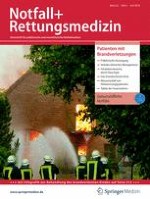24.07.2018 | Leitthema
Das brandverletzte Kind
Erschienen in: Notfall + Rettungsmedizin | Ausgabe 4/2019
Einloggen, um Zugang zu erhaltenZusammenfassung
Hintergrund
Thermische Verletzungen gehören zu den häufigsten Unfallursachen im Kindesalter und können erhebliche bleibende Schäden verursachen.
Ziel der Arbeit
In diesem Übersichtsbeitrag sollen die aktuellen Therapieempfehlungen für die prä- und innerklinische Versorgung von thermischen Verletzungen im Kindesalter zusammengefasst werden, wobei der Schwerpunkt auf die Besonderheiten in der Behandlung von Kindern gelegt wird.
Material und Methoden
Anhand der Literatur sowie klinischer Erfahrungen werden die aktuellen Therapieempfehlungen dargestellt und diskutiert.
Ergebnisse
Die Versorgung von thermischen Verletzungen im Kindesalter erfordert sowohl in der prä- als auch in der innerklinischen Versorgung ein differenziertes, an den kindlichen Organismus angepasstes Vorgehen. Die Herausforderung in der präklinischen Behandlung von kindlichen Notfällen besteht darin, trotz limitierter Erfahrungen eine möglichst optimale Versorgung zu gewährleisten. In den spezialisierten Kliniken bzw. Zentren für schwerbrandverletzte Kinder muss dann eine an das Ausmaß der thermischen Verletzung angepasste Weiterversorgung erfolgen. Dabei müssen spezielle Aspekte der Kinderintensivmedizin wie auch der operativen Therapie beachtet werden, um insbesondere langfristig zufriedenstellende funktionelle und kosmetische Ergebnisse mit möglichst geringen Einschränkungen zu erzielen.
Schlussfolgerung
Die Behandlung von (schwer-)brandverletzten Kindern erfordert eine enge interdisziplinäre Zusammenarbeit, beginnend bei der präklinischen Versorgung über die innerklinische Weiterbehandlung hin zu einer langfristigen Nachsorge.
Anzeige















